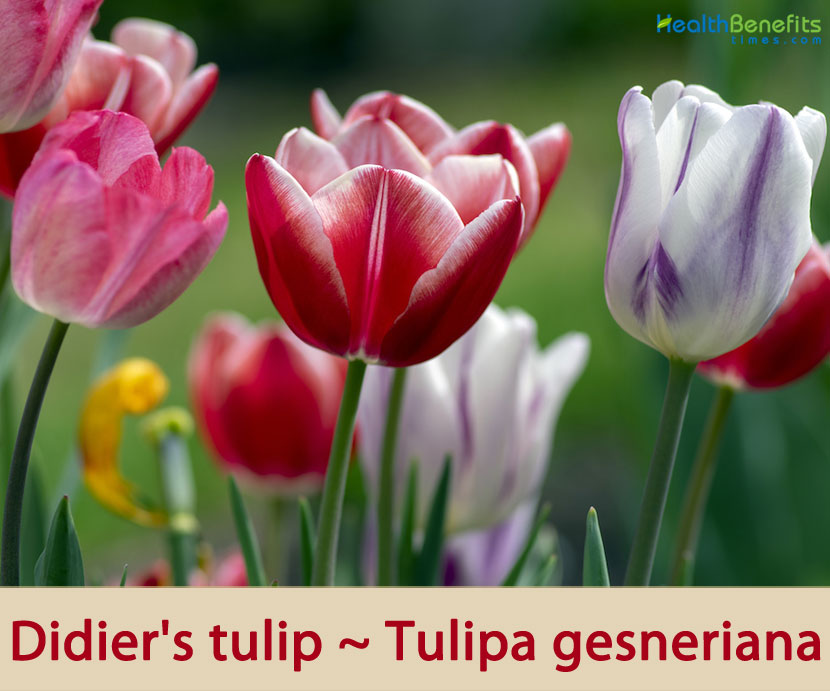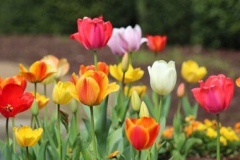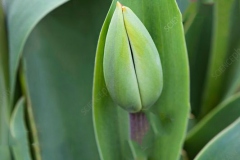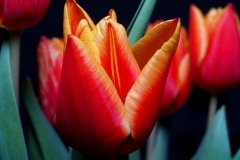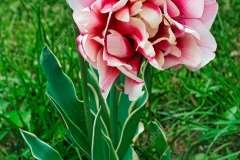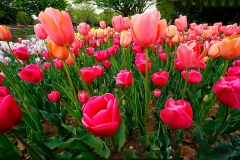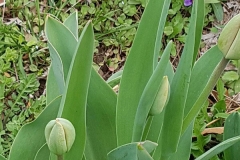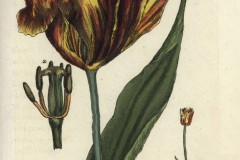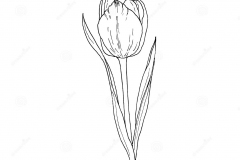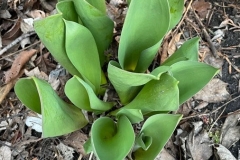| Didier's tulip Quick Facts | |
|---|---|
| Name: | Didier's tulip |
| Scientific Name: | Tulipa gesneriana |
| Origin | West to the Iberian Peninsula, through North Africa to Greece, the Balkans, Turkey |
| Shapes | Ellipsoid to subglobose, 3-angled, leathery capsules dehisces loculicidally |
| Health benefits | Beneficial for burns, skin rashes, insect bites, bee stings and many more |
| Name | Didier’s tulip |
|---|---|
| Scientific Name | Tulipa gesneriana |
| Native | Native range that stretches west to the Iberian Peninsula, through North Africa to Greece, the Balkans, Turkey, throughout the Levant (Syria, Israel, Palestine, Jordan) and Iran, north to the Ukraine, southern Siberia and Mongolia and east to the northwest of China |
| Common Names | Tulip, Didier’s Tulip, Garden Tulip, Tall Garden Tulip, Gesner’s tulip |
| Name in Other Languages | Albanian: Tulipan Brazil : Tulipa-De Jardim Bulgarian: Lale na Gesner (лале на Геснер) Chinese : Yu Jin Xiang (郁金香) Chuvash: Gesner tyul’panĕ (Геснер тюльпанӗ) Czech : Tulipán Zahradní Danish : Havetulipan, Have-tulipan, tulipán zahradní Estonian : Aedtulp English: Didier’s tulip, Garden Tulip, Gesner’s tulip, Tulip, Finnish: Tarhatulppaani French : Tulipe De Gesner, Tulipe Des Jardins, Tulipe, Tulipe des fleuristes German : Garten-Tulpe, Gesners Tulpe, Zucht- Tulpe Hebrew: צבעוני רחב עלים Hungarian: Kerti tulipán, pompás tulipán Icelandic : Garðatúlípani India : Tyūlipa Italian : Tulipano Di Gessner, Tulipano Japanese : Chūrippu (チューリップ) Korean : Tyullib (튤립) Latvian: Darzeline tulpe Lithuanian: Darželinė tulpė Norwegian: Borøytulipan Persian : Thoulyban, لاله باغچهای Portuguese : Tulipa, tulipa-de-jardim Russian : Tyul’pan, Тюльпан Геснера Serbian : Lala Slovak: Tulipán zahradní Spanish : Tulipán Swedish : Tulpan, Trädgårdstulpan Turkish : Tulbend, Turban, dağ lâlesi Upper Sorbian: Zahrodna tulpa Vietnamese : Cây Uât́ Kim Hương Welsh: Tiwlip yr Ardd, Tiwlipau’r Ardd |
| Plant Growth Habit | Bulbose, scapose to sub-scapose, herbaceous, perennial plant with papery to coriaceous, tunicate, often stoloniferous bulbs |
| Growing Climates | Man-made or disturbed habitats, meadows, cultivated land, roadsides, forest edges, rough ground, quarries, churchyards and amenity grasslands |
| Soil | Moist, fertile, well-drained neutral to slightly acid soil where they will receive full or at least afternoon sun |
| Plant Size | 35 to 45 centimeters |
| Leaf | Middle-green, simple leaves are alternate. They are lanceolate with entire margins. Lamina is linear to narrow oblong, and weakly fleshy. |
| Flowering season | April to May |
| Flower | Flower has three petals and three sepals which are often darker at the base. They are produced in white, yellow, orange, pink, red, maroon, purple, variegated and with coloured streaks, often blotched near base except blue |
| Fruit Shape & Size | Ellipsoid to subglobose, 3-angled, leathery capsules dehisces loculicidally |
| Seed | Seeds flat, numerous in 2 rows per locule |
| Precautions |
|
Plant Description
Didier’s tulip is a bulbose, scapose to sub-scapose, herbaceous, perennial plant with papery to coriaceous, tunicate, and often stoloniferous bulbs. The plant normally grows about 35 to 45 centimeters tall. The plant is found growing in man-made or disturbed habitats, meadows, cultivated land, roadsides, forest edges, rough ground, quarries, churchyards and amenity grasslands. The plant does best in moist, fertile, well-drained neutral to slightly acid soil where they will receive full or at least afternoon sun. It is a perennial plant that is grown from a bulb. It can be from four to 28 inches high, usually one flower per stem.
This tall, late-blooming species has a single blooming flower and linear or broadly lanceolate leaves. This is a complex hybridized neo-species, and can also be called Tulipa × gesneriana. Most of the cultivars of tulip are derived from Tulipa gesneriana. It has become naturalized in parts of central and southern Europe and distributed locations in North America.
Leaves
Tulipa gesneriana is deciduous. The middle-green, simple leaves are alternate. They are lanceolate with entire margins. Lamina is linear to narrow oblong, and weakly fleshy.
Flowers
Inflorescences are 1(−4)-flowered. The flower has three petals and three sepals which are often darker at the base. They are produced in white, yellow, orange, pink, red, maroon, purple, variegated and with coloured streaks, often blotched near base except blue. They have six distinct stamens with filaments shorter than tepals and basally dilated. Anthers are basifixed, linear to narrowly elliptic and introrse. Ovary is superior, 3-locular; style very short or absent; stigma prominently 3-lobed. Flowering normally takes place in between April to May.
Fruit
Fertile flowers are followed by ellipsoid to subglobose, 3-angled, leathery capsules dehisces loculicidally. The plant has disc-shaped seeds in two rose per chamber.
Traditional uses and benefits of Didier’s tulip
- Soothing poultice of the petals is used for burns, skin rashes, insect bites and bee stings.
- In the seventeenth century, young girls crushed red tulip petals and rubbed on cheeks so that the petals impart their color and the juice would help clear up any spots.
- Crushed petals and juice from the flower base are used to soothe scratches and rough skin on work-worn hands of tulip growers in Holland.
Culinary Uses
- Tulip bulbs are edible.
- Bulbs can be used as a substitute for onion in cooking.
- They can be dried, powdered and added to cereals or flour for making bread.
- Tulip flowers are also edible.
- Cooking with tulips dates back to the late sixteenth century when unopened flower buds were cooked with peas or finely cut green beans.
- Petals have little taste but can be used to garnish a dish, chop a few petals and mixed them in a salad, or the entire flower used for a fruit bowl.
- Petals can be sugared and used to decorate a cake or eaten with syrup as a dessert.
- Some of the recipes with tulip flowers listed by Roberts included tulip syrup, tulips stuffed with chicken mayonnaise and three-bean salad with tulips.
- During the recent Chelsea Flower Show, Chef Pascal Aussignac used tulip flowers as the base for a unique starter, stuffing them with a mixture of mushrooms, tapioca and parmesan and surrounding them with a pea puree.
Other Facts
- Tulips are the world’s most popular spring ornamental bulb flowers and are widely grown in temperate areas.
- They make beautiful flower gardens, beds and borders in parks and house gardens and also as potted plants.
- Tulips make excellent and long-lasting cut flowers in lovely and beautiful flower arrangements.
- They can be used for bridal bouquets, table center pieces and general wedding decor.
- They are also a great choice for a baby shower or as a gift for a new baby.
- Commercial tulip production occurs in some 15 countries worldwide, with the largest production area in the Netherlands.
- Plants have been grown indoors in pots in order to help remove toxins from the atmosphere.
- It has been shown to help remove formaldehyde, xylene and ammonia.
References:
https://www.itis.gov/servlet/SingleRpt/SingleRpt?search_topic=TSN&search_value=43105#null
https://pfaf.org/user/Plant.aspx?LatinName=Tulipa+gesneriana
https://en.wikipedia.org/wiki/Tulipa_gesneriana
http://www.narc.gov.jo/gringlobal/taxonomydetail.aspx?id=40734
https://gd.eppo.int/taxon/TULGE
https://www.cabi.org/isc/datasheet/117687


